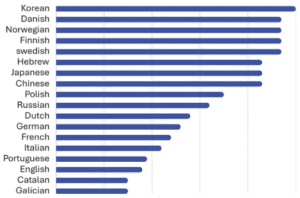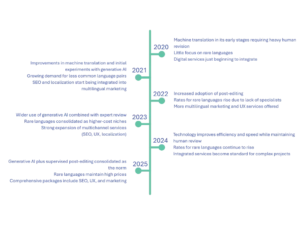When a company begins planning its expansion into new markets, the cost of translation services is usually one of the first factors put on the table. However, selecting providers solely by searching for the lowest translation prices can turn into a risky decision. In today’s global environment, where linguistic quality, consistent terminology, and cultural adaptation mark the difference between winning or losing a market, translation rates are no longer just figures on a quote; they become a strategic investment.
At Linguaserve, as experts in translation, we understand that the real value is not found in offering the cheapest translation quotes, but rather in ensuring that every single word communicates exactly what the brand wants to express, in the appropriate tone and context.
Factors that influence the cost of translation
There is no single formula to calculate translation rates. Instead, the price of translation services depends on a combination of variables that shape the final budget. Among the most common factors are:
- Source and target languages: translating from English into Spanish does not cost the same as translating from Japanese into German.
- Availability of translators: the harder it is to find professionals specialized in a given pair, the higher the translation prices will be.
- Level of specialization: medical, legal, or technical texts demand expert translators, which drives up translation quotes.
- Turnaround time: urgency may involve significant surcharges.
- Word count: more words do not always mean proportionally higher costs given that there may be volume discounts or discounts for repetitions.
- Additional services: editing, QA, terminology management, formatting, or multilingual SEO may be included in the translation rate or billed separately.
- Technology applied: the use of machine translation with human post-editing can reduce the overall cost of translation services, but it requires strict quality control.
What does a translation rate usually include?
- 🖋️ Translation
The translator’s main task, which goes beyond replacing words. It involves fully understanding the text, adapting it culturally, and applying the correct specialized terminology. - 🔍 Bilingual or monolingual review
A second linguist checks grammar, consistency, and style. This can be a bilingual review (by comparing with the source text) or a monolingual review (focusing on fluency and naturalness). - 🤖 Machine translation with post-editing
Translation engines speed up the process, but a human expert reviews and corrects the output to achieve professional standards. - ✅ Quality assurance (QA)
Automated tools are used to detect errors in numbers, formats, tags, or inconsistencies, ensuring the final text is flawless. - 📂 Project management
Coordination among translators, reviewers, and the client. This includes deadline management, glossary oversight, and effective communication. - ⏱️ Rush surcharge
Applied when the delivery time is very short. This allows additional resources to be assigned to meet the deadline. - 🌍 Complementary services
Multilingual SEO adaptation, subtitling, transcreation, software localization, or formatting. These services add value when content needs to perform in a digital or marketing environment.
This detailed breakdown is essential for understanding what you are truly paying for in a translation quote and for avoiding price comparisons made without proper context.
Which languages are the most expensive to translate?
One of the elements that most directly affects the cost of translation services is the language combination. Not all languages have the same number of available professionals, nor do they have the same demand. Looking at translations from Spanish, the differences can be grouped as follows:
- High-cost languages: Japanese, Korean, Arabic, the Nordic languages (Norwegian, Icelandic, Danish), and less common European languages such as Hungarian or Finnish.
- Medium-cost languages: French, German, Italian, and Dutch.
- Low-cost languages: Portuguese, English, or Spain’s co-official languages.
The reason is not simply that some languages are rare; it is also the relationship between supply and demand. For instance, there are far fewer translators specialized in Icelandic, which automatically increases translation prices.
In conclusion, there is no single translation rate that applies to all cases: the chosen language pair largely defines the translation quote.
Translation quotes in 2025: What’s typical?
Speaking about a “standard” in 2025 means analyzing the issue from three angles: service levels, language comparisons, and market trends.
Standards by service level
In 2025, the translation market increasingly organizes translation rates by the added value of the service:
- Basic: translation only, without an additional review.
- Professional: translation plus review by a second linguist.
- Premium: translation, review, QA, project management, and technical support.
This system makes it clear that translation prices depend both on the quality level required and on the services included in the project.
Ranking of the most and least expensive languages
The cost of translation is also tied to the source and target languages. A visual ranking makes it easy to see the differences between languages at a glance, taking Spanish as the source language:
This information allows companies to plan their translation budgets realistically in line with their target markets.
Trends in 2025: Beyond the numbers
In addition to translation rates, the industry is being shaped by broader trends:
- Machine translation or generative AI with post-editing: increasingly common. This approach helps reduce costs, but it requires careful expert supervision to maintain quality.
- Rare languages on the rise: language combinations with fewer qualified professionals continue to increase in price year after year.
- Integrated services: clients want more than just translation. They demand services tied to SEO, UX, and multilingual digital marketing, which increases overall translation prices.
The cost of translation services should never be analyzed in isolation. A low translation quote without editing or QA can end up being extremely costly if international communication fails. A carefully designed translation budget that matches your needs, with the right level of quality and expert professionals, is always the best investment.
At Linguaserve, we help brands communicate with the world with both precision and a personal touch. Would you like to know the best option for your project? Our team is here to guide you in finding the perfect balance between cost and value.





